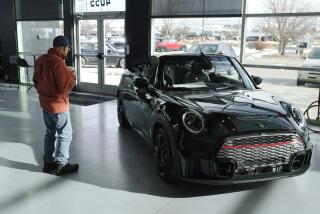Big Three Sales for ’91 Model Year Down 7%
- Share via
DETROIT — The 1991 model year creaked mercifully to a close as September sales of cars and trucks slid 7.0%, compared to September, 1990, bringing total sales of the unfortunate 1991 models to 12.75 million--the lowest level since 1983.
“The 1991 model year proved to a period which the U.S. auto industry is glad to have behind it,” said James Fitzpatrick, vice president of communications and marketing at General Motors Corp. as the auto industry reported its sales results Thursday.
Vehicles sold at a faster annual rate last month than they have since October, 1990, but analysts and dealers said the numbers, inflated by large blocks of sales to rental companies and corporate fleets, masked the still-sorry state of the retail car and truck market.
“This is ‘fleet crazy’ time, when the big corporate buyers dominate the market,” warned Tom Webb, chief economist for the National Automobile Dealers Assn. “With the tail wagging the dog, these numbers don’t say much about where the real market is headed.”
Fleet purchases have swelled to about one-third of new car sales for the Big Three U.S. auto makers, leaving them increasingly dependent on fleet customers as they scramble to defend their diminishing market share from their Japanese competitors.
Dealers battered by more than a year of sluggish sales are hoping that the 1992 models arriving in their showrooms will inspire lukewarm consumers to buy. But few expect a significant spurt soon.
“There are some industries in which the recession may be over, but the domestic car business is not one of them,” said Bob Longpre, whose 90-day forecast for his Pontiac dealership in Westminster is decidedly dim despite the anticipated arrival of GM’s redesigned Pontiac Grand Am and Bonneville.
Even Roger Miller, whose Huntington Beach Honda dealership has weathered the recession better than many of the domestics, is not optimistic. Though the new 1992 Honda Civic will be a big draw, Miller said, “there’s just not a lot of confidence out there.”
Joseph Philippi, an analyst with Shearson Lehman Bros. in New York, said customers won’t buy until auto makers cut prices on their vehicles. “There’s a bit of a buyer revolt under way. Customers are literally walking out of showrooms in disgust,” he said.
Seeking to placate the querulous American consumer, Chrysler Corp. said it will cut its planned price increase for 1992 domestic cars Thursday to nine-tenths of a percent over 1991 models, rather than the planned 1.4% increase.
The Big Three auto makers have already announced their second round of rebates on some 1992 models. Philippi estimated that the domestic manufacturers are now spending more than $1,250 per vehicle in rebates and incentive programs, a number he predicted will soar to $1,500 by December. Japanese auto makers spend about $700 per vehicle on such programs, Philippi said.
Led by GM with a 13.1% sales skid for September, compared to September, 1990, the Big Three posted a combined 8.7% decline in vehicle sales for the month. Ford said sales slipped 3.7%, and Chrysler posted a 5.2% decline. The Japanese auto makers said sales were up 1.2% over last September. Honda sales jumped 11.6%, Toyota was up by 0.2%, while Nissan and Mazda posted respective declines of 9.5% and 4.8%.






